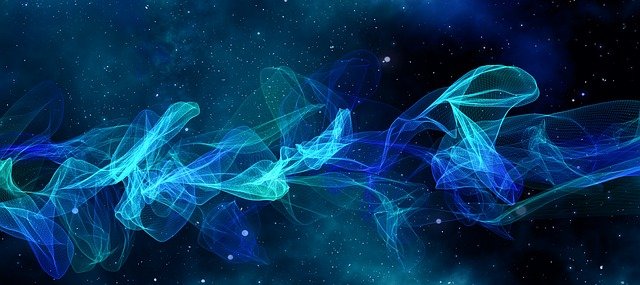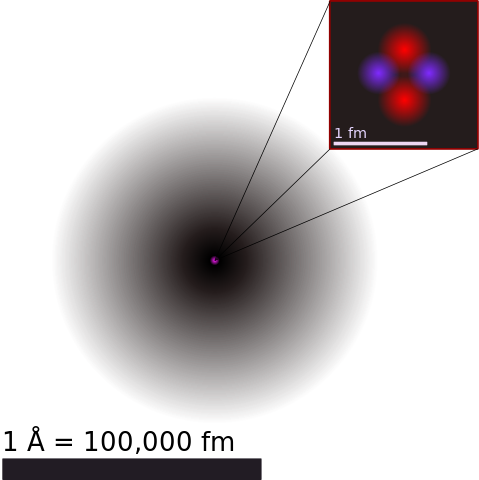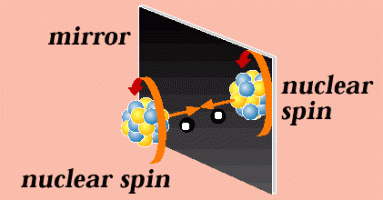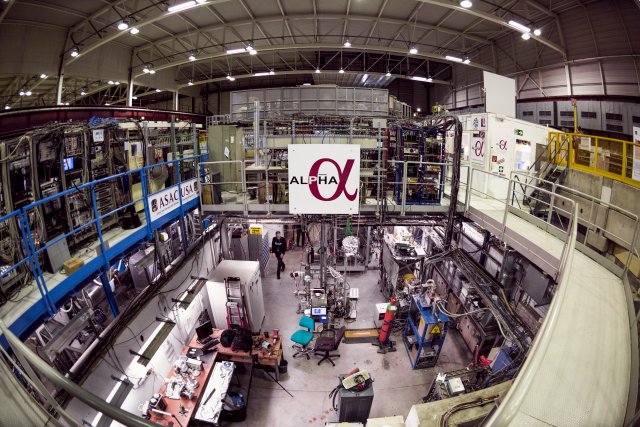Probing antimatter in its deepest details at CERN
Several experiments at CERN are successfully probing antimatter and its properties in order to (try to) falsify the validity of the so-called CPT symmetry, one of the most fundamental symmetries of nature. Showing that this symmetry does not hold would indeed have profound implications for our understanding of our universe.

[image credits: Pixabay (CC0)]
Last April, the ALPHA collaboration released brand new results about a test that physicists have been trying for the last 30 years.
It has shown, with an unprecedented level of precision, that the transition between the first two antihydrogen levels of energy is similar to the one occurring between the corresponding hydrogen levels.
Equivalently, hydrogen and antihydrogen are very alike, as could be expected from the CPT symmetry.
As can be guessed from this potentially complicated introduction, this post will be about antimatter, the CPT symmetry, energy levels and the fresh measurement carried by the ALPHA experiment.
WHAT ARE ANTIATOMS?
In the world of the elementary particles, each particle comes with an antiparticle partner that possesses many similar properties, like the same mass or the same lifetime. However, particles and antiparticles have opposite quantum numbers, the most well-known of these being the electric charge.
Let us take the example of the electron and the positron. They consist of a particle and an antiparticle whose only difference consists in their electric charge: the positron has a positive electric charge and the electron has a negative one.

[image credits: Wikipedia]
Whilst the elementary particles are the most basic building blocks of nature, they form composite objects known as protons and neutrons.
The latter are the basic constituents of the plethora of different atomic nuclei pervading our world.
And example is shown with the atom on the picture on the right, where two neutrons (blue) and two protons (red) form a helium nucleus.
Atoms are then formed from an atomic nucleus and a bunch of orbiting electrons (the grey zone on the picture).
Antiatoms work in the same ways, but one uses elementary particles to build antiprotons and antineutrons as a started. In practice, each ingredient of a proton or a neutron has been replaced by the corresponding anti-ingredient.
Antiprotons and antineutrons then form the composite objects known as antiatomic nuclei, and adding a bunch of orbiting positrons leads us to what is an antiatom.
THE ENERGY LEVELS
The exact configuration of the electrons around the atomic nucleus defines the so-called level of energy of the atom.
The fundamental level, or the ground state, consists in the configuration in which the electrons are closest to the nucleus. In this case, the total atom energy is minimum.
The excited levels of energy are then defined by configurations where one or more electrons are a bit further and with a larger energy.
For this reason, when one gets a transition from an excited level to the ground state, some energy is radiated away.
The further electrons are from the nucleus, the more excited is the configuration. What is important for the following are the first two levels, the fundamental one and the first excited one.
And of course, anything said holds for antiatoms as well, after having replaced every particle stuff by its antiparticle counterpart.
THE CPT SYMMETRY
There is not much difference between a particle and an antiparticle. But why are antiparticles and particles so similar? The reason is pretty straightforward when one starts from quantum field theory: a quantum field is a single object embedding both particles and antiparticles, as detailed here.
Therefore, after defining the properties of a given quantum field, one gets automatically similar particle and antiparticle properties.
Bonus comment: now, one can easily understand the reason why I sometimes receive requests from some scientific journals on agriculture…

[image credits: LBL]
Moreover, the way in which the particles eat, drink and dance is embedded in a function of these quantum fields.
One can demonstrate that this function is invariant under the joint action of the charge (C), parity (P) and time-reversal (T) transformations.
And as C+P+T = CPT. Here is where the name of the CPT symmetry comes from… Very imaginative!
The P transformation means that the spatial configuration of the particles is reversed (as when one looks through a mirror).
The C transformation implies the replacement of all particles by the corresponding antiparticles.
The T transformation changes the arrow of time, making time running backwards.
In other words, all of this means that the laws of nature are invariant under a joint C, P and T transformation. And the common goal of most matter-antimatter comparison experiments is to assess the validity of the fact that nature is CPT symmetric.
THE ALPHA EXPERIMENT FIGHTING THE CPT SYMMETRY
The ALPHA experiment focuses on the antihydrogen atom, that is the simplest possible antiatom.

[image credits: CERN]
Its nucleus is made of one antiproton, and there is a single surrounding positron. This is the antimatter counterpart of the hydrogen atom that is made of a single proton and one orbiting electron.
In order to try to falsify the CPT symmetry, physicists managed to measure, with an unprecedented precision, the energy released during the transition between the first two antihydrogen energy levels.
The results have been found to agree with the corresponding transition in the hydrogen atom at a precision of 2 x 10-12.
This has been achieved by first producing antihydrogen atoms from a beam of decelerated antiprotons that are combined with positrons. The antiatoms are then trapped in a magnetic field and finally bombarded with a laser.
The laser has been tuned at the right frequency, so that it could allow for the transition between the first two antihydrogen energy levels. The conclusions are then driven by comparing the antihydrogen reaction with the hydrogen one.
The CPT invariance of the laws for nature is thus still very alive!
TL; DR
In this post, I briefly described one of the most fundamental symmetries of nature: the CPT symmetry. One way to probe it is to study the properties of some matter particles and the corresponding antiparticles, these properties being expected to be strongly related.
For instance, the transition between the two most stable configurations of the hydrogen atom and the one between the two most stable configurations of the antihydrogen atom have to be identical.
This is what the ALPHA experiment revealed a month ago: at the 0.000000000002 level, these transitions match! The CPT symmetry is thus very valid and very alive! Pffeeewww, the Standard Model is saved ;)
For more information, please have a look to the official CERN press release.
A stupid stuff is hidden in this post… Can you find it? And it is not connected to agriculture (this is stupid as well, but too obvious) ;)
STEEMSTEM
SteemSTEM is a community-driven project that now runs on Steem for more than 1.5 year. We seek to build a community of science lovers and to make the Steem blockchain a better place for Science Technology Engineering and Mathematics (STEM).
More information can be found on the @steemstem blog, on our discord server and in our last project report. Please also have a look on this post for what concerns the building of our community.
Your posts are like ogres... which are like onions: they have layers. On the surface, I understand what's going on. But, when I start trying to peel back the layers, I always find something that my little pea brain can't fathom. In this case, it was the part about the T in CPT.
When you say,
... is this a theoretical concept, or can we actually measure time going in reverse?
This is a symmetry operation that is theoretically well defined. We act on the function describing how all particles behave, and we get a result telling us how all particle will behave after time reversal.
There are actually experiments managing to measure time reversal violation, like in BaBar for instance.
We also have this work where a reaction and the reverse ones were both studied.
does that mean that at the moment of big bang the anti-universe started moving backwards in time so we'll never see it ? it beats schoolbooks but it's still quite the read i can tell you , but it's amazing stuff, that's for sure, i hope you can keep this up through the years
This is the topic of another post (See here) :) There is no proof there is a anti-universe. This is just another theory that may be correct or not. Data will hopefully tell us at some point ^^
yes, let's hope so :) i'm slightly fascinated by the concept of entropy over time which as i jokingly like to say is best observed in one's kitchen after 24 hours of leaving it alone. And i might have mentioned this before but i also struggle with the notion that time is actually real and not just an illusion by observation, or a constant or variable in formula, a construct if you will, like
pardon my lack of professional jargon, i didnt go to school for this lol.
euh ... so the real forces like gravity and how things move to equilibrium which is somewhat alike i think since gravity is also a form of moving to a state of equilibrium as planets fall around each other, they don't really actually rotate do they, they're constantly falling, looking for the 'spot in the middle' where they are in balance but never finding it (luckily for us). And these things create the illusion of time but time is not an actual physical entity or force, just like numbers aren't they are constructs, they don't really exist anywhere but in mathematics and the human (or hopefully alien) mind as the dolphins would have said lol
im not sure i'm making sense to someone with a clinical scientific background but i struggle with it because there is no real evidence of time as a force, it's merely observed because real forces put everything in motion so time is only used to make formulas possible ... phew ... lol , so i don't know
i never expected talking to an actual particle physicist either but here i am .. and thanks for the link i'll make sure to check it out. The one thing i think i understand is that you cant have matter and antimatter in the same place because it would 'even out' and destroy one another, right ?
the idea of an anti-universe is quite enticing though, just like mirror dimensions which havent been proven and even if, might just be an infinite number of copies of this one without any difference at all , right? it's not because you have infinity that there has to be a difference.
Maybe in a next life i can reincarnate at cern lol, that would be nice for a change, thanks again for taking time
and maybe those snazzy simulations on tv would show better if the universe was depicted vertically so the planets fall instead of roll around heh ... maybe, i'll leave that to the experts
Time is a very complex thing. I added this topic on my to-write list of post after a comment of yours some weeks ago. But still struggling to find time (yeah :p) to write thus post. Don't worry, in due time (re-yeah) it will come ;)
That is correct. There are searches for antimatter regions in our universe, but the limits are really strong. If they exist, they should consist in at most 0.01% of our universe. Not a big number ;)
certainly not a number that pays out here hahah , i don' want to push myself but it's been on my mind for quite a while, "why do clinical physicists accept time without proof" ? :)
i dont worry, im glad i found someone who can actually reflect my brainspasms into the real world lol
i thought i might have said that before i can get unstuck in time sometimes myself , if it gets proven as a force it would be quite something to have
like a new player in the game
:)
I really appreciate your humility ("little pea brain") as I share it, too.
I just realized after reading your comment for the 3rd time, that you're asking about symmetry in reverse of time. I wasn't even thinking about that during my reading of the OP.
I remember you once replied in one of my comments in your post that there are some particles that are their own antiparticles; if I'm not mistaking. But in this case, would they have opposite quantum numbers?
Hope I'm not asking a stupid question? :)
Everything you said is correct. And the only number who is its own opposite is 0. Therefore, in order for a particle to be its own antiparticle, it has in particular to be electrically neutral.
This was not a stupid question! :)
Thanks for the quick lectures sir :)
My pleasure :)
Encore un article passionant qui m'a pas du tout donnée mal à la tête ;)
Finally this has the consequence that there may be some anti-us deeper in the universe made of antimatter.
The day we want to make an exchange with them, we have to worry/agree on what we call matter and antimatter so as not to make a mistake with catastrophic consequences (Ok celle là l'ai piqué à Etienne Klein de mémoire hahahaha)
Merci pour ton commentaire!
Unfortunately, the observations do not seem to agree with this statement. I think that the fraction of antimatter regions in the universe is below 0.01%. So not too much worries for now :)
As this is my first time ever coming across the subject of "antiparticles", I feel a little bit lost. But the tldr at the bottom did me a lot of good and virtually made my curiosity piqued. Now I am all in for understanding what these fundamental symmetries of nature are in the first place. About CPT, from your explanations about the similarity of particles and antiparticles, it looks very logical and probable, I am wondering why anyone would dispute its authenticity at all.
And yes, I can't help but think that this has a very strange correlation with this:
Even if CPT originates from quantum field theory, scientists like to challenge everything. This may open the door to something new, a new vision of seeing our world, etc... This is the scientific method in its full strength :)
The stupid thing is not the agriculture stuff. This is a funny parenthesis slightly too obvious. Hint: please check the links I provided ;)
Regarding journal solicitations based on 'quantum fields', I dare you to submit an abstract along the lines of keeping your seeds in an indeterminate state and only observing the crop at harvest time so that you can choose the best plant for the market needs.
Exactly! You got the entire point. In the Monte Carlo simulation of the LHC collisions, the random seeds clearly matter!
Didn't know this exists. Does that mean there are also other anti-particles and is there an anti-me?? :-)
And if particles and anti-particles are based on the same quantum functions, is it also possible to have more than just two instances of one atomic state? Something like antihydrogen, antihydrogen1, antihydrogen2 etc..?
You should move the tldr; segment to the top. I accidentally read the entire post..
In practice, one could have anti-everything. However, producing antiatoms is a pain and we have managed to produce so far only a couple of atomic species (antihydrogen and antohelium). Therefore, we are far from being able to get your antiyou :)
Usually, what is referred to as antihydrogen is uniquely defined: it is an antiatom made of one antiproton and one positron. However, in the same way we have several isotopes of each atom, we could have several isotopes of the antiatoms.
This is on purpose: the summary comes at the end ;)
Does that mean the quantum functions are only serving the purpose of allowing states based on known subatomic particles? Or the other way around: What did we know first, positrons or the quantum functions that describe them?
I know that now and I will not fall for it again:-)
The positron was discovered after the birth of quantum mechanics. In fact, antiparticles appeared naturally i the theory (the development of Klein-Gordon and Dirac equations) and physicists from that time were not understanding what they were.
To answer your question: The wave functions will be different for the different (anti)atomic species.
I hope it helps!
This topic is waaay above me, but actually yes, I can imagine something to what you've said. Thanks for that.
You are very welcome!
If I am not mistaken, each particle can have its antiparticle which has the same mass but opposite electric and magnetic properties. The opposite of a proton is an antiproton; the opposite of a electron is a antielectron or a positron. So if you join them together you get an antihydrogen atom - the physical laws are the same for antimatter and matter (even their spectrum!). In theory nothing stops you from having an antiparticle of any atom but in practice antimatter is very hard to deal with since you can't store it like regular matter. If it touches anything it annihilates and "reduces" to energy (EM radiation / elementary particles)
This is correct. This is also what I said in my post ;)
It sounds like magnetic and electric are the same. What if for example there are several magnetic dimensions? This would open the possibility for another type of antiparticle.
There are not exactly the same. Particles would accelerate in an electric field whilst magnetic fields can be used to control their track.
Sorry, but I didn't understand the question. Can you be more specific? There is no such a thing like a magnetic dimension (only space and time here).
Thanks for replying to a complete physics dork:-)
With magnetic dimensions, I had in mind that magnetic fields have a plus and a minus pole and I thought perhaps there could be particles with more than one pole for each, something like that:
Or is this a different kind of particle.. or two merged into one?
Wait a second.. I just realize my error: With such a configuration, the magnetic fields would merge and result in a new plus/minus pair.
Not bad. I answered my own physics question. It may have been a dumb one, but I'm also kind of a bit proud of myself:-)
There are systems (i.e. not particles themselves but things more complex) that have more than one pole. For instance, at the LHC, we have dipole magnets, but also quadrupoles (like in the picture or here).
Hello @lemouth, another interesting read! Thanks for those blogs, I learn a lot and I'm so excited! I just can't hide it!
So basically what I get is that electrons need energy in order to beat some sort of gravitational force induced by the nucleus and therefore move away, right?
You know, the pleasure is also for me to write about it. Sharing some physics with everyone is cool ^^
Not gravity. Gravity is negligible here. But you have the electromagnetic attraction from the nucleus that is positively charged. The electrons are organized into shells around the nucleus, and depending in which shell they are (closer or further), their energy will be more and less larger.
Alright, I see, thanks for taking the time to provide further info!
The pleasure is for me. I always answer a question (if not, this means I simply missed it and you have the right to re-insist ;) )
I understand. I feel like it is my duty to respond to all questions made on my scientific posts. You've never missed any of my questions, you're a machine! :P
This is my secret. Please don't spread it ^^
I won't let the cat out of the bag :P
the e-cat please ;)
are then defined by configurations where one or more electrons are a bit further and with a larger energy.
Pls can you explain and throw more light about this ,?
The fundamental state corresponds to the case where all electrons are located as close as possible (and as allowed) to the nucleus. Excited states are states with a different configurations, where at least one electron is further.
The fundamental state is the one for which the energy is minimum. For the excited states, the electrons are more energetic and thus the total energy of the state is larger.
Is it clearer?
Yes sir , it is.
Thank you!
You are very welcome!
I was so enamored with my joke, I forgot to ask my actual question.
Let's make the big supposition that we could make buckets of stable antiatoms. If I understand CPT's implications well enough, this means all the emergent properties of matter would be the same for antimatter - stuff like, 2 antihydrogens + 1 antioxygen would make antiwater, fusion and fission would be a thing, and the reaction products would be the same (although the anti-version). Is that correct?
This is correct :)
So, what your'e saying is that I could be a particle physicist? Sweet!
Next serious question. If antihydrogen has the same spectral lines and such, is there any way we could detect it from afar apart from looking for matter/antimatter collisions?
I've googled this a bit and it seems like the answer is 'not really, but if you're thinking about antimatter galaxies, lots of stuff about the early universe suggests that antimatter and matter existed in equal amounts, but we're clearly seeing a lot of matter, so the antimatter must've been annihilated.'
I don't think I fully get it, since that seems like a case of circular reasoning and I'm pretty sure it's not supposed to be.
:)
I am not sure to understand the question. Antihydrogen must be produced and this is tough. Producing it means detecting it, somehow, as we know what we produce (and we then observe what is going on.
There is a limit on the amount of antimatter in the universe. It is of the order of at most 0.01%. We could have that amount of antimatter and still be in agreement with data.
I'm so excited and I just can't hide it for reading this post ;)
Go back to your fundamental state... this is better... I thing those are becoming too easy to catch. I am too predictive ;)
Somebody must teach me how to do this thing.
Which thing? Being too predictive or excited? :D
I'm always excited by default.
But finding those song lyrics in your post is beyond me.